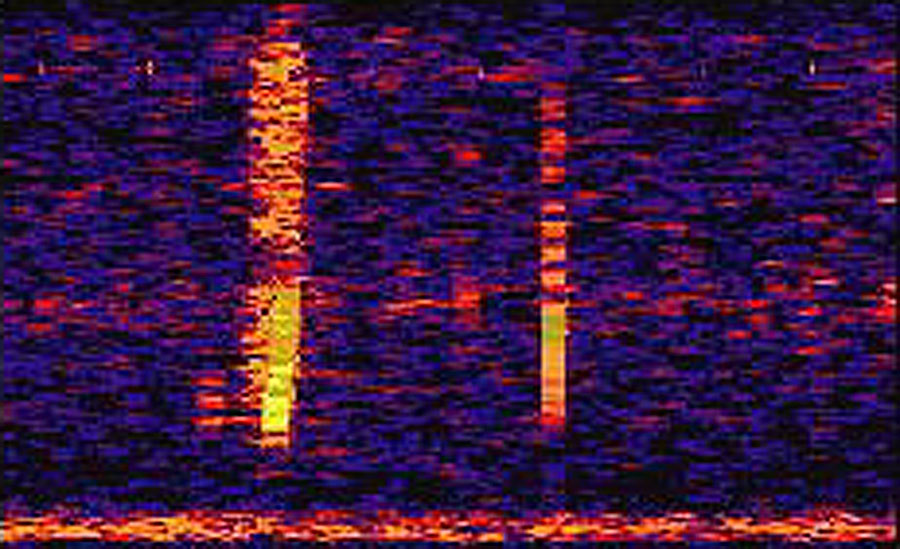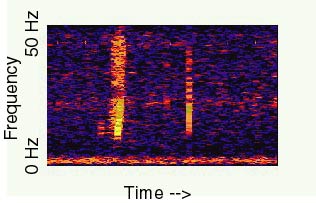|
|
|
| The
BLOOP NOTE: This signal is not connected to space as far as we currently know, but am including it in this section as an anomalous signal The
Bloop: A Mysterious Sound from
Explanation:the Deep Ocean | NOAA SOSUS
What created this strange sound in Earth's Pacific Ocean? Pictured above is a visual representation of a loud and unusual sound, dubbed a Bloop, captured by deep sea microphones in 1997. In the above graph, time is shown on the horizontal axis, deep pitch is shown on the vertical axis, and brightness designates loudness. Although Bloops are some of the loudest sounds of any type ever recorded in Earth's oceans, their origin remains unknown. The Bloop sound was placed as occurring several times off the southern coast of South America and was audible 5,000 kilometers away. Although the sound has similarities to those vocalized by living organisms, not even a blue whale is large enough to croon this loud. The sounds point to the intriguing hypothesis that even larger life forms lurk in the unexplored darkness of Earth's deep oceans. A less imagination-inspiring possibility, however, is that the sounds resulted from some sort of iceberg calving. No further Bloops have been heard since 1997, although other loud and unexplained sounds have been recorded. Source: NASA APOD |
|
|
The
BLOOP
Maybe these weird sounds that were recorded were a Kraken mating call?  Bloop was an ultra-low-frequency and extremely powerful underwater sound detected by the U.S. National Oceanic and Atmospheric Administration (NOAA) in 1997. The sound was consistent with the noises generated by icequakes in large icebergs, or large icebergs scraping the ocean floor.  A spectrogram of Bloop Analysis
The
Bloop - WikipediaThe sound's source was
roughly triangulated to 50°S 100°WCoordinates:
50°S 100°W (a remote point in the south
Pacific Ocean west of the southern tip of
South America), and the sound was detected
several times by the Equatorial Pacific Ocean
autonomous hydrophone array. This system was
developed as an autonomous array of
hydrophones that could be deployed in any
oceanographic region to monitor specific
phenomena. It is primarily used to monitor
undersea seismicity, ice noise, and marine
mammal population and migration. This is a
stand-alone system designed and built by
NOAA's Pacific Marine Environmental Laboratory
(PMEL) to augment NOAA's use of the U.S. Navy
Sound Surveillance System (SOSUS), which was
equipment originally designed to detect Soviet
submarines.
 Bloop
at 16x the original speed, from the NOAA
website. Bloop
at 16x the original speed, from the NOAA
website.According to the NOAA description, it "r[ose] rapidly in frequency over about one minute and was of sufficient amplitude to be heard on multiple sensors, at a range of over 5,000 km (3106.86 miles)." The NOAA's Dr. Christopher Fox did not believe its origin was man-made, such as a submarine or bomb, nor familiar geological events such as volcanoes or earthquakes. While the audio profile of Bloop does resemble that of a living creature,[2] the source was a mystery both because it was different from known sounds and because it was several times louder than the loudest recorded animal, the blue whale. A number of other significant sounds have been named by NOAA: Julia, Train, Slow Down, Whistle and Upsweep. Dr. Christopher Fox of the NOAA initially speculated that Bloop may be ice calving in Antarctica. A year later journalist David Wolman paraphrased Dr. Fox's updated opinion that it was probably animal in origin: Fox's hunch is that the sound nicknamed Bloop is the most likely to come from some sort of animal, because its signature is a rapid variation in frequency similar to that of sounds known to be made by marine beasts. There's one crucial difference, however: in 1997 Bloop was detected by sensors up to 4800 kilometres (2982.582 miles) apart. That means it must be far louder than any whale noise, or any other animal noise for that matter. Is it even remotely possible that some creature bigger than any whale is lurking in the ocean depths? Or, perhaps more likely, something that is much more efficient at making sound?The NOAA Vents Program has since then attributed the sound to that of a large icequake. Numerous icequakes share similar spectrograms with Bloop, as well as the amplitude necessary to spot them despite ranges exceeding 5000 km. This was found during the tracking of iceberg A53a as it disintegrated near South Georgia Island in early 2008. If this is indeed the origin of Bloop, the iceberg(s) involved in generating the sound were most likely between Bransfield Straits and the Ross Sea; or possibly at Cape Adare, a well-known source of cryogenic signals |
|
References:
Related Links: |
|
| FAIR USE NOTICE: This page contains copyrighted material the use of which has not been specifically authorized by the copyright owner. Pegasus Research Consortium distributes this material without profit to those who have expressed a prior interest in receiving the included information for research and educational purposes. We believe this constitutes a fair use of any such copyrighted material as provided for in 17 U.S.C § 107. If you wish to use copyrighted material from this site for purposes of your own that go beyond fair use, you must obtain permission from the copyright owner. | |
|
|
